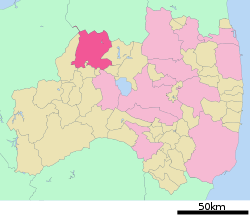Kitakata, Fukushima
| Kitakata 喜多方市 | |||
|---|---|---|---|
| City | |||
|
Kitakata City Hall | |||
| |||
 Location of Kitakata in Fukushima Prefecture | |||
 Kitakata
| |||
| Coordinates: 37°39′N 139°52′E / 37.650°N 139.867°ECoordinates: 37°39′N 139°52′E / 37.650°N 139.867°E | |||
| Country | Japan | ||
| Region | Tōhoku | ||
| Prefecture | Fukushima Prefecture | ||
| Government | |||
| • - Mayor | Hideo Shirai | ||
| Area | |||
| • Total | 554.67 km2 (214.16 sq mi) | ||
| Population (September 2014) | |||
| • Total | 49,857 | ||
| • Density | 89.9/km2 (233/sq mi) | ||
| Time zone | Japan Standard Time (UTC+9) | ||
| Symbols | |||
| • Tree | Cryptomeria | ||
| • Flower | Himesayuri (Lilium rubellum) | ||
| • Bird | Wagtail | ||
| • Fish | Three-spined stickleback | ||
| • Insect | Firefly | ||
| Phone number | 0241-24-5211 | ||
| Address | 7244-2 Oshimizuhigashi, Kitakata-shi, Fukushima-ken 966-8601 | ||
| Website | Kitakata City HP | ||
Kitakata (喜多方市 Kitakata-shi) is a city located in Fukushima Prefecture, in northern Honshū, Japan. As of September 2014, the city had an estimated population of 49,857 and a population density of 89.9 persons per km2. The total area was 554.67 km2. Kitakata was once written '北方', which meant 'northern place'.[1]
Geography
Kitakami is located at the far northern Aizu region of Fukushima Prefecture, bordered by Yamagata Prefecture to the north.
Neighboring municipalities
- Aizuwakamatsu, Fukushima
- Nishiaizu, Fukushima
- Kitashiobara, Fukushima
- Bandai, Fukushima
- Aizubange, Fukushima
- Yugawa, Fukushima
- Yonezawa, Yamagata
- Iide, Yamagata
- Oguni, Yamagata
- Shibata, Niigata
- Aga, Niigata
History
The area of present-day Kitakata was part of ancient Mutsu Province, and formed part of the holdings of Aizu Domain during the Edo period. After the Meiji Restoration, it was organized as part of Yama District, and Kitakata was established as a town in 1875. . In 1882, more than 3,000 peasants gathered at the Danjo-ga-hara Field in Shiokawa and then marched on the Kitakata Police Station to rebel against the oppression of the prefectural government. Known as the Kitakata Incident of 1882, it was the first people's rights movement in the Tohoku area.[1]
Kitakata Town was raised to city status on March 31, 1954. On January 4, 2006, the towns of Shiokawa and Yamato, and the villages of Atsushiokanō and Takasato (all from Yama District) were merged into Kitakata.
Transportation
Railway
Highway
Sister city relations
 Wilsonville, Oregon, United States
Wilsonville, Oregon, United States
Local attractions
Kitakata is well known for its distinctive ramen. The area within its former city boundaries has the highest per-capita number of ramen establishments in Japan. Ramen has such prominence in the region that locally, the word soba usually refers to ramen, and not to actual soba which is referred to as nihon soba ("Japanese soba"). Kitakata's ramen consists of rather thick, flat, curly noodles served in a pork and niboshi broth.
The city has over 2,600 kura storehouses which are now typically used as sake breweries, living quarters and workshops.[2]
Noted people from Kitakata
- Uryu Iwako – social worker
External links
![]() Media related to Kitakata, Fukushima at Wikimedia Commons
Media related to Kitakata, Fukushima at Wikimedia Commons
- Kitakata City official website (Japanese)
- Kitakata Sightseeing Association (Japanese)
